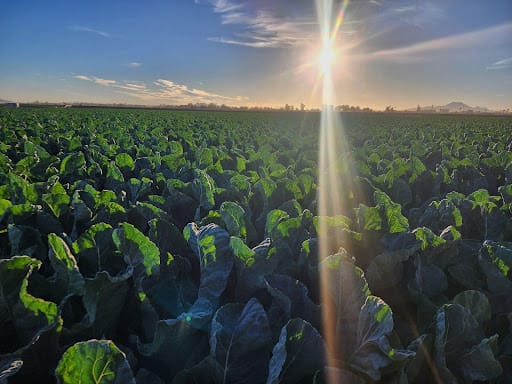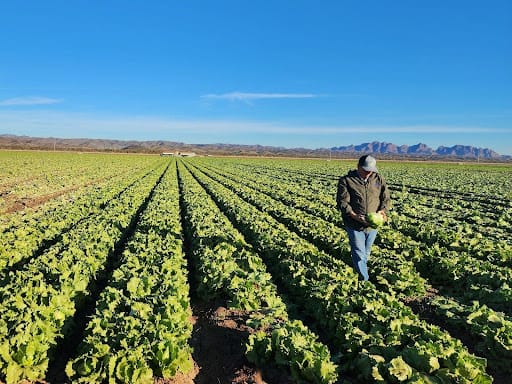By Emily Cai, ASU sustainable food systems graduate student
Farming is an economics game and nobody knows this better than John Boelts.

On the second morning of our Food and Farm Immersive, our graduate student cohort drove to Desert Premium Farms in Yuma, Arizona. The sun was rising picturesquely over a field of cauliflower and the temperature was 60 degrees and climbing. Balmy, compared to my home in Vermont, where the same day would be a high of 35 degrees, barely reaching above freezing – an inhospitable winter climate to the crops we saw growing at Desert Premium.
Desert Premium Farms is a 2500-acre operation run by John Boelts, his wife Alicia, and his partner Kent Inglett. They grow on rented land. Along with vegetables like lettuce, broccoli, and cauliflower, their crops also include a few hundred acres of spring and fall melons and 1500 acres of crops like Durum wheat and cotton. “And anything else we can try to lose money at,” Boelts says. He’s joking – ostensibly.
But in the same thought he reveals that it costs about 15-20 million dollars a year to run this operation. At the end of the year, the hope is to make a couple hundred thousand dollars of profit. If this doesn’t seem like great business, it’s not because Boelts isn’t a businessman. He knows the numbers – he can tell you the cost of each acre of vegetable from seed to harvest and beyond. He knows exactly where he’s saving and where he’s spending: as we stand in front of a field of lettuce, he explains the harvest process down to the hour, the price down the cent. A 4% rate of return may not seem like good business, but it’s the price of a food system that stocks lettuce in supermarkets year-round across the country. After all, “Everybody needs food,” says Boelts.
This is also the reason why Desert Premium uses conventional agricultural practices. For Boelts, conventional practices allow him to produce higher yields at a lower cost. Herbicides provide an efficient and cost-effective method for weed management, whereas the organic alternative would cost him hundreds of dollars per acre just for the labor of hand-weeding. Whether you agree or not, Desert Premium’s growing practices are rooted in a philosophy of access. “For conventional production,” Boelts explains, “I can do it much more efficiently, which means it’s more affordable for everybody. Especially for those with the least means among us.”

Conventional production is also linked to Boelts’ idea of sustainability. A sustainable farm is, after all, one that can stay in business.
Throughout our weeklong tour of Arizona farms, the issue of sustainability was most salient in the context of water: we repeatedly heard throughout our Food and Farm Immersive that the Colorado River – whose water is over-allocated among seven separate states – is the biggest sustainability issue faced by farmers in the region. The impacts of climate change will only compound this issue: as rainfall decreases and seasons grow warmer, the need for water in Arizona will only increase while the source itself depletes. This is a stark contrast to the Northeast, where the impacts of climate change will manifest in markedly soggier conditions.1 As Arizona plods through a 23-year megadrought, Vermont farms and farmers seek disaster relief from unprecedented rains and flooding during the month of July. “Sustainability – it’s like talking about water,” Boelts says. “How you feel about water depends on how deep you are in the river.”
But sustainability in farming is not just about natural resources – regardless of region, it’s also a question of economics and the financial viability of an operation. How do we continue to farm and feed people in a system where farms are barely, if at all, profitable? Everybody needs food, after all. ”Ag has always been this way. It’s not unusual,” Boelts says. He predicts that, in the future, profit margins will shrink even further, ultimately becoming untenable. “If prices aren’t able to rise to meet our cost of production in the United States, we’ll just continue importing products.”
That’s not the future Boelts wants. As the 1st Vice President of the Arizona Farm Bureau, Boelts advocates on behalf of agricultural producers – ensuring that they are able to stay in business while also maintaining a food supply that is both affordable and abundant. It’s a hard balance to strike, especially given the higher demand for production in increasingly unfavorable conditions. “At some point, somebody has to produce a field of lettuce that you get a head out of,” Boelts says. “And you’re willing to work with the system that gets that product to you if you want that salad.”
1http://www.nrcc.cornell.edu/services/blog/2023/11/15/index.html#:~:text=The%20Northeast%20is%20getting%20wetter.&text=The%20North east%20is%20expected%20to,these%20events%20has%20also%20increased.
This blog is part of a series from the Swette Center's annual Arizona Food and Farm Immersion, a required course in their two graduate programs. Students tour the state, meeting with farmers, ranchers, entrepreneurs, government staff, and non-profit leaders.